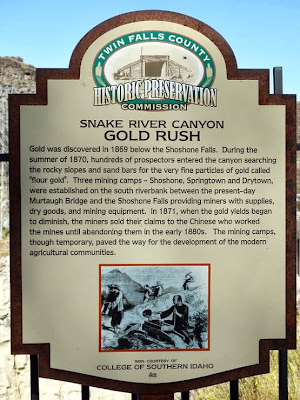Lake Bonneville, the ancient ancestor of the Great Salt Lake, flooded this area about 15,000 years ago. Twin Falls, so named because of the two cataracts that originally poured over these rocks, was formed by that flood as were Shoshone Falls and several others on the Snake River. The 600-foot deep Snake River gorge was carved through solid rock by up to 33 million cubic feet of water per second traveling at 70 miles per hour across the Snake River plain.
More recently, in 1935 Idaho Power began construction of an upstream arch dam and adjacent non-overflow dam installing an electric generating plant in the latter. The non-overflow dam eliminated the flow of one of the two cataracts. This plant continues to operate and generates 9 megawatts of power whenever river flows are in the range of 100 to 1,000 cubic feet per second. A newer plant was constructed in 1995 to supplement the original plant whenever river flows are in the range of 1,000 to 4,000 cubic feet per second. Above 4,000 cfs, both plants operate together. According to information from Idaho Power, these two plants are capable of providing electricity to approximately 31,900 homes.
 |
| Info Sign About the Hydro Project |
 |
| Info about the Snake River Canyon Gold Rush |
 |
| The Dam |
 |
| The Snake River heading to Shoshone Falls |
After some pictures, we drove back up the steep access road out of the gorge and headed off to run some necessary errands before driving back to the Oregon Trail Campground.







No comments:
Post a Comment